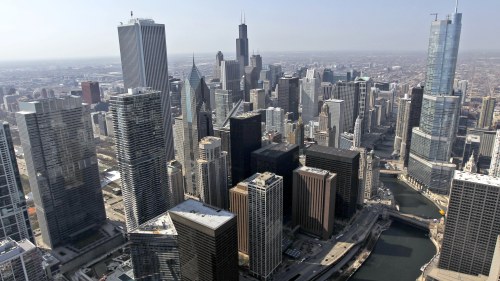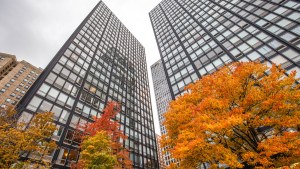Green with envy? Chicago's sustainable architecture scene

Chicago is known the world over for its bold and unique architecture. After all, it’s the birthplace of the skyscraper. But how does the city compare globally when it comes to sustainable architecture?
Many of the iconic commercial buildings of the late 19th century that put Chicago on the architectural map are some of the most energy efficient today. Architects of that time constructed buildings with inherent sustainable features that responded to location and climate.
“Energy was scarce and expensive, so you didn’t want buildings that were terribly inefficient, but that was it,” said Doug Farr of Farr Associates, a Chicago-based sustainability-driven architecture and urban design firm. "Part of their energy efficiency comes from the fact that they were simpler buildings."
Buildings of that era tended to be constructed with masonry; have smaller floor plans; thick, load-bearing walls; high ceilings; punched windows instead of floor-to-ceiling glass; and natural ventilation. Architects drew from classical architectural principles to help shade, cool, and circulate air. The northern half of Chicago's famous Monadnock Building, a proto-skyscraper designed by architects Burnham & Root, is a prime example.
"The windows open, it’s still heated the way it was in 1891 when it was built — and that’s by hot water radiators. It uses very little energy per square foot. And so, it remains an exemplar of energy efficiency today,” Farr said.
At 16 stories, the Monadnock is also the tallest commercial building in the world with load-bearing brick walls — and one of the last constructed this way. It represents a transitional period in architectural history. Later buildings used steel and concrete to support structural weight, and mechanical heating and cooling to ventilate — modern features that increased energy consumption and carbon footprints.
A harmful era
But Chicago’s architectural influence hasn’t always been positive. According to Farr, some of Chicago’s least energy efficient buildings were built in the 1950s — and, for better or worse, served as an inspiration to architects across the globe.
The second architectural era Chicago is known for is the mid-century, launched by Ludwig Mies van der Rohe's iconic 860-880 Lake Shore Drive towers. The “Glass House apartments,” as they’re affectionately known, are about 85 percent façade glass and have some of the highest Energy Use Intensity (EUIs) in the city, Farr explained. And generations of architects looked to them for inspiration.
“We exported the glass box the world over,” said Farr, who is also founder of the Climate Action Museum. “And in doing so, we more or less doubled the amount of energy that buildings use, compared to if we had never invented it.”
Buildings and construction now account for about 40 percent of CO2 emissions and 35 percent of energy consumption globally, according to a report by the United Nations Environment Programme and the International Energy Agency. And the majority of modern buildings have little resilience to climate change.
Subscribe to ChicagoGlobal
This story first appeared in the ChicagoGlobal newsletter, a joint project of Crain's Chicago Business and the Chicago Council on Global Affairs.
But with a focus on codes, standards and green-building certifications, a lot of progress has been made regarding the quality and performance of new buildings. According to Juliane Wolf, Design Principal and Partner at Studio Gang, "the next step is to look at how they’re constructed and reduce the carbon emitted when building the buildings.”
In cities like Chicago, where the vast majority of building stock will still be in place several years from now, addressing carbon and energy use in existing structures is just as important, if not more. Wolf says retrofitting is an effective way to reduce emissions because those buildings already have embodied carbon from their initial production, transportation, and construction — as much as 50 percent of whole life carbon emissions.
What is sustainable architecture anyway?
It means different things, depending on where you are and who you ask. Generally, it seeks to minimize the negative impact of buildings on the environment. It can be done by installing renewable water and energy systems, incorporating “green” or vegetated rooftops, sourcing low-impact materials and retrofitting old buildings, among others. But it can also mean designing to the local environment to maximize sustainability.
“For me, it's the ability for development to meet the needs of today without compromising future generations,” said Nigerian architect Kunlé Adeyemi of NLÉ, a firm focusing on innovative and sustainable architecture in developing cities in Africa. “It’s focused on people, but an important aspect of that is the environment, where we hold it on almost equal terms as humans.”
Adeyemi considers the social, economic, and environmental impacts of every architectural project. Using local resources and materials is important. So is understanding where the structure will sit (in a city or forest, on a hill, by a river or the ocean, etc.), how it will interact with nature’s elements such as the sun and wind, and the demographics and needs of the people who will use it.
“There are varying factors that affect sustainability in different cities, countries and regions,” he said. “Amsterdam may be tackling decongesting its center to make it more pedestrian friendly as a strategy for sustainable development, while Lagos may be building more infrastructure, such as railroads and marine navigation, to ensure clean mobility within the city.”
Adeyemi added that some of the solutions to sustainable architecture we seek today may have less to do with discovering new technologies and ideas, and more to do with unlearning some of the things we’ve done and revisiting ancient solutions to living and evolving with the environment.

The Monadnock Building. Photo by Eric Allix Rogers.

860-880 Lake Shore Drive. Photo by Jussi Toivanen.
Where does that leave Chicago?
“We’re behind our European peers. We stack up more closely with American peer cities,” said Ian Spula, content manager at the Chicago Architecture Center.
Chicago’s strong winds and cold, snowy winters contribute to its unique environment. But many of its buildings tend to be glassy, which is contrary to what they should be, given the climate. The energy used to power those and other buildings represents about 70 percent of Chicago’s greenhouse gas emissions.
“We’re a heating-dominant climate,” said Farr. “Three to four times more energy is used to heat than cool.”
Despite that, the city has a high share of energy-efficient buildings. About 71 percent of office space is LEED or Energy Star certified. Chicago is only the seventh city in the world to achieve LEED for Cities Platinum — the U.S. Green Building Council’s highest level of certification. And it has an internationally recognized program for retrofitting older buildings to increase energy efficiency.
“We really look to our biggest buildings, our high-rises, our major investments not just to meet code but to exceed it; to be the drivers of innovation and demonstrate what can be done," said Grant Ullrich, managing deputy building commissioner with the city of Chicago. “And I think we really see that through what we’ve done in the past and what we continue to do.”
Chicago also has several initiatives in place to promote sustainable building practices, including:
- Chicago Sustainable Development Policy: requires new construction and renovation projects receiving financial assistance or special approvals from the city to include sustainable features
- Chicago Energy Transformation Code: applies to building permits and incentivizes the use of equipment types and energy sources that will save energy and reduce carbon footprints for residential and commercial buildings
- Chicago Energy Benchmarking Ordinance: requires residential, commercial, and institutional buildings 50,000 square feet or more to track and report energy consumption annually
- Construction and Demolition Debris Recycling: mandates that contractors recycle at least 50 percent of recyclable construction and demolition debris generated in a project
“We have a tremendous amount of professional expertise in architecture, engineering and construction," said Ullrich. “The companies and professionals based here who work around the world are incredibly generous in sharing their expertise with the city when we’re developing policies and initiatives around trying to make our hometown more sustainable, meet national and international climate goals, and address the climate crisis through our built environment.”
This story first appeared in the ChicagoGlobal newsletter, a joint project of Crain's Chicago Business and the Chicago Council on Global Affairs. Subscribe today.

